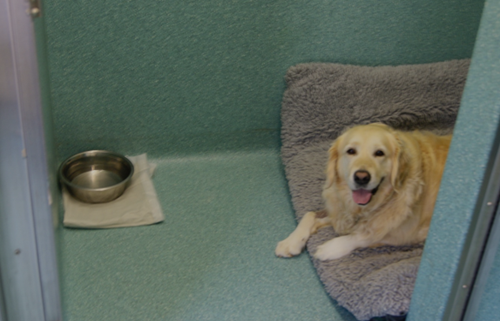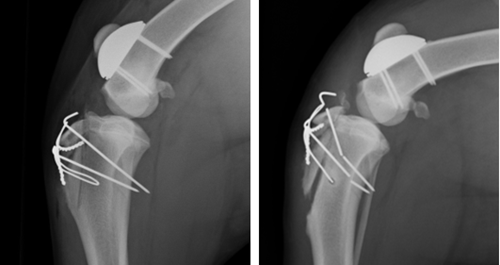Instructions for patients after TPLO
Your pet has had a tibial osteotomy. It is important that he/she is strictly rested for the following 12 WEEKS.
Sutures are present and should be removed by your vet in 14 days
Painkillers: NSAIDs are typical for 4 to 6 weeks post op
Antibiotics: 5 days antibiotics is routine after a major osteotomy
Future appointments:
- With your vet to check the wounds in 3 to 5 days and to remove the sutures in 14 days there are a row of sutures medially and a single proximomedially and distomedially and couple laterally
- Back here with Patrick starved in 6 weeks for X rays, the cost of this is covered in the fee
Please make sure that Pickle is not allowed to lick at the wound, this will cause an infection and lead to potentially serious complications, a Buster Collar has been provided.
Exercise
- 0 to 8 weeks, lead controlled toileting only confined to a cage, crate at all other times
- 8 to 12 weeks, after x rays are taken exercise may be slowly built up to a maximum of 10 minutes three to four times daily on a lead
- Avoid all play, stairs, jumping on furniture
Physiotherapy is an important part of the recovery process and this should include:
- Icing the area, use a bag of frozen peas applied to the area through two layers of a tea towel for up to 20 minutes three times a day.
- Massage of the leg.
- Gentle lead walking, this should be done slowly to encourage your dog to use its leg.
If you are in any way concerned with your dog’s progress contact your vet straight away
The importance of post operative control
It is vital that dogs and cats are suitably controlled after they have had orthopaedic surgery. If you or I had surgery to repair a fracture or stabilise a cruciate rupture or simply had an arthroscopy we would be confined to crutches to avoid putting any weight through the affected leg or kept in bed to rest the repaired fracture completely. We cannot tell our patients to rest and so we rely completely on our patients being confined in the healing phase of treatment. If we do not confine our patients after surgery they will use the operated leg too much and potentially cause problems, cage or crate confinement is the only way to do this. If your post op instructions ask for cage or crate please make sure this is the case.
Problems that may develop include: that the lameness doesn’t improve because the tissues are not being rested, that joints that have been stabilised become unstable or it may be that fractures or osteotomies (bone cuts) that have been fixed with implants become unstable and require significant further surgery.
Catastrophic failures can occur from time to time if patients are not confined. Patients that require further surgery are more likely to have subsequent failures and complications.
This is Jenny, she has had a surgery that involves cutting the tibia and realigning it with screws and plate, this is the size of confinement that she needs for 8 weeks after surgery, no more. She has enough room for her bed and water and food bowl. She comes out four times a day on a lead to go to the toilet, she goes out for 100yds for toileting and then comes back in, a toilet walk does not mean going for a walk.

For cats and dogs less than 20kg a collapsible transport cage is all that is required, these can be purchased from Argos or pet shops. For larger patients larger cages can be purchased or you can create a pen in the corner of the room. Your dog or cat will not want to be in the cage so make sure it is not in the middle of the house with everything going on around it, have it somewhere quiet so that your dog or cat can accept the confinement and can rest.
Allowing your dog to wander around the house, jump on furniture, play with other dogs, go up and down stairs or go outside for toileting without being on a lead will risk catastrophic failure which may require further surgery and in the worst case could even potentially risk your dog’s life. The X rays below are of a dog that was allowed to wander around the house unconfined after surgery, he could jump up at the door when people arrived and this resulted in a catastrophic failure of his osteotomy.

We do everything possible to maximise your pet’s recovery, we ask that you do everything you can to avoid problems that can be avoided. It is completely understandable that you will feel sorry for your dog or cat after surgery and that you feel bad for them being confined to a pen or cage or crate but please think how bad you will feel for them if they have to undergo surgery again to fix a problem because you didn’t do everything you could for them.
Pat Ridge